|
|
 |
Fiche d'espèce de Copépode |
|
|
Cyclopoida ( Ordre ) |
|
|
|
Corycaeidae ( Famille ) |
|
|
|
Corycaeus ( Genre ) |
|
|
|
Onychocorycaeus ( Sous-Genre ) |
|
|
| |
Corycaeus (Onychocorycaeus) pumilus M. Dahl, 1912 (F,M) | |
| | | | | | | Syn.: | Corycaeus medius Gurney, 1927 (p.165, figs.F,M, Rem.); Sewell, 1948 (p.441); El-Serehy & al., 2001 (p.116, Table 1: abundance vs transect in Suez Canal); El-Serehy & al., 2013 (p.2099, Rem.: p.2101)
Onychocorycaeus pumilus : Binet, 1984 (tab.3); 1985 (p.85, tab.3); Boxshall & Halsey, 2004 (p.493, as pumilis); McKinnon & al., 2008 (p.844: Tab.1); Vives & Shmeleva, 2010 (p.240, figs.F,M, Rem.) | | | | Ref.: | | | M. Dahl, 1912 (p.91, figs.F,M); Farran, 1936 a (p.138, Rem.); Sewell, 1947 (p.287, Rem.F, Rem.: comparison between pumilus and medius.); Tanaka, 1960 (p.86, figs.M, Rem.); Fagetti, 1962 (p.54); Chen & al., 1974 (p.64, figs.F); Chihara & Murano, 1997 (p.966, Pl.216,217: F,M); |  issued from : Q.-c Chen & S.-z. Zhang & C.-s. Zhu in Studia Marina Sinica, 1974, 9. [Pl.21, Figs.14-17]. Female (from China Seas): 14, habitus (dorsal); 15, A2; 16, terminal spine of exopodite 3 of P2; 17, P4.
|
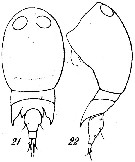 issued from : M. Dahl in Ergebnisse der Plankton-Expedition der Humboldt-Stiftung. Bd II, G. f1. I. Die Corycaeinen 1912. [Taf.XII, Figs.21, 22]. Female: 21, habitus (dorsal); 22, idem (lateral left side).
|
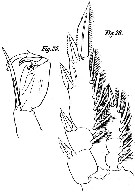 issued from : M. Dahl in Ergebnisse der Plankton-Expedition der Humboldt-Stiftung. Bd II, G. f1. I. Die Corycaeinen 1912. [Taf.XII, Figs.25, 28]. Female: 25, A2; 28, P2.
|
 issued from : M. Dahl in Ergebnisse der Plankton-Expedition der Humboldt-Stiftung. Bd II, G. f1. I. Die Corycaeinen 1912. [Taf.XII, Figs.23, 24]. Male: 23, habitus (dorsal); 24, idem (lateral right side).
|
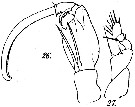 issued from : M. Dahl in Ergebnisse der Plankton-Expedition der Humboldt-Stiftung. Bd II, G. f1. I. Die Corycaeinen 1912. [Taf.XII, Figs.26, 27]. Male: 26, A2; 27, P2
|
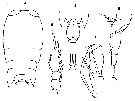 Issued from : O. Tanaka in Spec. Publs. Seto mar. biol. Lab., 10, 1960 [Pl. XXXVII, 4-8]. Male (from 35°09'S, 20°13'E): 4, cephalothorax (dorsal); 5, abdomen (dorsal); 6, same (lateral); 7, A2; 8, exopod of P2. Nota: - Cephalothorax and abdomen in the proportional lengths 62 to 38. - Head about as long as broad; eyes separated by 3/5 of its greatest diameter. - Wing-like expansion of the 3rd thoracic segment to the level of the 1/3 of the genital segment. - Posterior orocesses of the 4th thoracic segment terminates into small slightly outturned prominences. - Abdominal segments and caudal rami in the proportional lengths 49 : 25 : 26 = 100. - Genital segment 1.7 times as long as broad; ventral surface with a small median hook which directs somewhat posteriorly; cylindrical part of the segment half the length of the segment; no spinules observed on the posterior border of the segment. - Anal segment of the same width throughout its length, and 2 times as long as broad. - In A2 the spine arising from the 1st basal segment about as long as that from the 23nd segment. - Terminal spine of the 3rd exopodal segment of P2 straight and of usual structure.
|
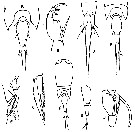 Issued from : R. Gurney in Trans.zool. Soc. London, 1927, 22. [p.166, Fiog.26]. As Corycaeus medius. Female (from Suez Canal): A, last thoracic segments and abdomen (dorsal); B, A2; C, terminal spine of exopodal segment 3 of P2; D, anal somite and furca; E, P4. Male (from Port Taufiq: Suez): F, habitus (dorsal); G, abdomen (lateral); H, last thoracic segments and abdomen (dorsal); J, A2. Nota female: - Thorax nearly twice the length of the abdomen (49 : 26). - Eyes separated by about 2/3 their greatest diameter. - 1st thoracic somite nearly 1/2 total length of body, about 3/4 as wide as long. - 3rd somite with broad, backwardly pointing wings, very sharp at ends and reaching beyond middle of genital somite. - 4th somite distinctly marked off dorsally from third and produced on either side into a short pointed process. - Genital somite 2/3 as wide as long (29 : 20) with 1 seta at each genital opening. Ventral margin straight, without hook. Relative length of genital somite, anal somite and furca 29 : 11 : 9. - Furca short, usually divergent. Width of ramus nearly 1/2 length (7 : 18). Longest seta more than 4 times as long as furca (37 : 9). - A2 resembles that of C. catus, 2nd segment a little more than 1/2 as broad as long, and inner margin ending in 2 very strong teeth. Terminal claw short, scarcely longer than 3rd segment. Spine of basal segment very long, reaching far beyond end of 2nd segment; nearly 3 times as long as spine of 2nd segment. Terminal spine of exopod of P2 straight. - Terminal spine of P3 of same length as 3rd segment. Nota male: - Abdomen about 2/3 length of thorax. - Eyes separated by half greatest diameter. - 3rd thoracic somite with long tapering processes reaching about 1/3 length genital somite. - Processes of 4th somite with small, slightly out-turned points. - Relative length of genital somite, anal somite and furca 31 : 15 : 15. - Genital somite with distinct anterior ventral hook. - Longest seta of furca more than twice as long as furca (37 =: 15). - Terminal spine of P2 straight. - Terminal spine of P1 shorter than 3rd segment. - Endopod of P4 with 1 seta.
| | | | | Ref. compl.: | | | Wilson, 1942 a (p.182); Sewell, 1948 (p.393); C.B. Wilson, 1950 (p.195); Kovalev & Shmeleva, 1982 (p.86); Greze & al., 1985 (p.8, as pumilis); Shih & Young, 1995 (p.76); Noda & al., 1998 (p.55, Table 3, occurrence); Lavaniegos & Gonzalez-Navarro, 1999 (p.239, Appx.1); Ueda & al., 2000 (tab.1); Lo & al., 2001 (1139, tab.I); Lo & al., 2004 (p.89, tab.1); Hwang & al., 2006 (p.943, tabl. I); Hwang & al., 2007 (p.25); Tseng L.-C. & al., 2008 (p.153, fig.5, Table 2, occurrence vs geographic distribution, indicator species); Tseng L.-C. & al., 2008 (p.46, table 2, abundance vs moonsons); C.-Y. Lee & al., 2009 (p.151, Tab.2); Tseng L.-C. & al., 2011 (p.47, Table 2, occurrences vs mesh sizes); Johan & al., 2012 (2013) (p.1, Table 1); Tseng & al., 2012 (p.621, Table 3: abundance); Palomares-Garcia & al., 2018 (p.178, Table 1: occurrence) | | | | NZ: | 14 | | |
|
Carte de distribution de Corycaeus (Onychocorycaeus) pumilus par zones géographiques
|
| | | | | | | | | | | | | Loc: | | | South Africa (off Cape of Good Hope), Ibero-moroccan Bay, Medit. (Alboran Sea, Port Saïd), Suez Canal, Ismaïlia, Port Taufiq, Red Sea, Arabian Sea, Madagascar (Nosy Bé), Indonesia-Malaysia, Sarawak: Bintulu coast, Bismarck Archipelago, Philippines, China Seas (East China Sea, South China Sea), Taiwan (S, SW, N: Mienhua Canyon, NW, NE), S Japan (Kuchinoerabu Is.), Japan, Australia (North West Cape, Great Barrier), New Caledonia, off Hawaii, Pacif. (N tropical), off W Clipperton Is., S Baja California (La Paz), G. of California, off N Chile, Bering Sea, Aleutian Is. | | | | N: | 35 | | | | Lg.: | | | (11) F: 0,73-0,65; (34) F: 0,76-0,66; M: 0,7; (66) M: 0,73; (109) F: 0,77-0,75; (178) F: 0,74-0,80; M: 0,66; (666) F: 0,68-0,65; M: 0,65-0,63; (866) F: 0,81; M: 0,7; {F: 0,65-0,81; M: 0,63-0,73} | | | | Rem.: | Pour Sewell (1947, p.287) les différences de taille entre C. medius et C. pumilus sont dues aux différences de salinité relativement importantes entre les deux sites (Canal de Suez pour la première, et l'Archipel Bismarck pour la seconde). Les différences de température entre les deux sites ne sont cependant pas évoquées.
La présence de cette espèce dans l’extrême Pacifique nord est étonnante.
La dénomination pumilis est sans doute plus correcte.
Voir aussi les remarques en anglais | | | Dernière mise à jour : 13/11/2020 | |
|
|
 Toute utilisation de ce site pour une publication sera mentionnée avec la référence suivante : Toute utilisation de ce site pour une publication sera mentionnée avec la référence suivante :
Razouls C., Desreumaux N., Kouwenberg J. et de Bovée F., 2005-2025. - Biodiversité des Copépodes planctoniques marins (morphologie, répartition géographique et données biologiques). Sorbonne Université, CNRS. Disponible sur http://copepodes.obs-banyuls.fr [Accédé le 25 octobre 2025] © copyright 2005-2025 Sorbonne Université, CNRS
|
|
 |
 |










